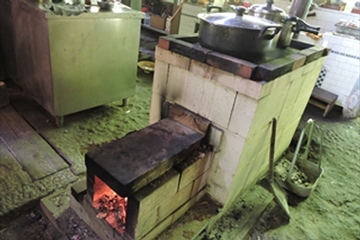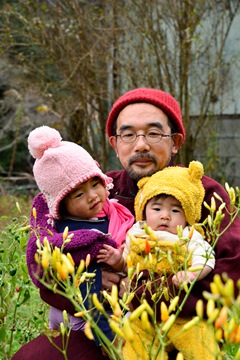Fire, Water, and Soil: The Simple Life as Resistance and Renewal
Kamata Yoji 1 (Japan)
Representative, Soranoie Living and Learning Center of Cosmos / ALFP 2006 Fellow
Climate change is a symbol of human stupidity. We go on destroying the very foundation of life, but we are too deluded to stop—and pretty soon, we will basically be living on borrowed time. The way the world works now is a tyrannical setup, one where people exploit others’ shortsightedness and enable the same behavior to put themselves in an advantageous position. I can’t just sit by and let that happen, though. When I think of future generations, the world they will be dealing with, I know that I have to do something. Trying to keep my body healthy and my mind sound, I push myself forward with a determination to believe in, and seek out, a path of hope for the future. I will never be able to change the fact that I am a part of the world’s problems, but that inescapable culpability does not mean that I cannot also be part of the solution. If I envision a better world, I need to live by my word. That’s my personal policy, no more, no less—but it fosters a kind of joie de vivre for me, one day at a time.

a natural farm nearby
I am challenging myself to a kind of social experiment: adopting a “one planet” lifestyle, a mode of living that stays within Earth’s natural limitations. It is just one of the things that I can do to help make the world a sustainable place, so I thought I would give it a try—and it has been well worth it. It is a rejuvenating, rewarding way to go about daily life. I do virtually all of my cooking on a wood-burning rocket kitchen stove. My fuel supply relies partly on bamboo, which I get from the grove out back. I head out, pick up some dead stalks and crack them apart with my hands and feet. Using the bamboo on my property does more than just provide a sustainable source of energy; it keeps the grove tidy, for one thing, and healthy, too. If you let a grove grow wild and neglect proper care, you will end up with weak-rooted bamboo that could pose a significant hazard—overgrowth makes the entire grove susceptible to landslides. A well-kept backyard grove can literally be a lifesaver.
Fuel is just one benefit of bamboo. Every April and May, I have been able to pluck loads of takenoko (bamboo shoots) from my grove. The haul is always way more than I can eat, so I have been sending my surplus supply of takenoko to my friends in radiation-contaminated areas in the Tohoku and Kanto regions. It is my own little take on the gift-economy concept, I suppose. That is still not enough to use up all the takenoko, though, so I dry the rest—and it tastes fantastic. The texture is what does it, I think; it is a chewy, tough consistency, kind of like dried squid (surume), so I call it “Neo-Ninja Food: Mountain Surume.” Why “Neo-Ninja”? Well, part of the reason is that I live in an area with a rich ninja history. Speculation abounds on how and where the ninja tradition started, but one popular theory traces the start back to a local ruling clan that thought the Imperial Court was spying on them. The family had iron-making technology—which, at the time, was still a cutting-edge rarity—and decided to use its arsenal to wage a hit-and-run, guerilla-style campaign against the suspected spies. The drama all took place in a mountain village, they say, right around where I now make my home. That is enough about ninjas, though—back to the topic at hand. Using the bamboo from out back to cook food has such a rich range of benefits: it keeps the grove in good, healthy condition, forms a vital link in a small-scale, self-sufficient economy to call my own, and even gives me a veritable bounty of great-tasting food. It is incredible how good it feels to know that my bamboo consumption is not perpetuating any vicious cycle; the more bamboo I use, the better the cycle actually is. Fire is a primordial thing, an element that’s been a vital strain of human life since time immemorial. The fire in my home, so central to everyday life, kindles a real, warm appreciation for that heritage.
I get all my water—for both cooking and drinking—from a bucket-type well. Some wells go dry when there is not enough rain or get muddy when there is too much, but, luckily, my well never has any weather-related problems. Although raising and lowering the bucket obviously makes for more work, you would be surprised at all the advantages that come with the bucket style: hand-drawing not only prevents stagnation but also jostles the surface of the water, aerating the fluid as it moves up and down. In a way, it is like the well and I share a kind of symbiotic, parallel connection: when I go to get water for my own health and well-being, I am actually benefiting the well’s health and well-being, too. That is why every sip of water from the well is so refreshing—for my body and my soul. The water stays pretty much the same temperature year-round, making for a warm, soothing effect in the winter and the perfect splash of cool refreshment during the summer months. It is great for the occasional outdoor bath, too.
The water around me is full of less happy memories, however. The fresh stream near my house, flowing in its pristine, idyllic beauty, takes on a forlorn hue when you see the monstrous anachronism of the Kawakami Dam towering over it and know about the sprawling network of sewer lines around it. Locals, tapping into the spirit of their ninja heritage, steeled themselves in resistance to the dam plan when it first reared its head. The fight was all to no avail, though; the plan was a zombie, for lack of a better word, with the government resurrecting it time and time again until it finally quashed the resistance fifty years ago. My refusal to use those waterworks, my commitment to using my own water, my determination to keep my surroundings healthy and viable for future generations—they are all forms of my modest attempt to sustain the resistance against centralized, destructive water development.
I answer the call of nature out in my garden. “Nature’s way” is such a great way to relieve yourself. When I lived in the city, I always felt like I needed to use a flush toilet. It was some kind of gut reaction to a natural urge, I guess. The weird thing, though, is that the actual act of it all felt so wasteful; I would deposit a bit of myself, as it were, in the receptacle of the toilet, like it was something to get rid of—worthless trash. Then I would flush it away along with some precious water and valuable energy, using all those resources just to empty myself. It eventually hit me: I was a waste machine. Going to the bathroom in my garden, on the other hand, is the opposite. It is a productive exercise, with each and every trip (many times a day!) making the soil more fertile and my harvests more plentiful. Ever since coming to that realization, I cannot help but feel like I am missing a chance to better the earth if I am ever out of the house and need to use the facilities. I wish I didn’t have to. My new bathroom routine works great for me, but it has not really caught on with my family or the other people living at the house. For women, there are the privacy issues that come with a completely exposed setting. I can’t build any barriers to block sightlines because it would be pointless to fertilize a single area of soil over and over again; the “bathroom” needs to be room-less and nomadic. The other big snag is how the idea of food and human excrement sharing a common habitat just does not compute in people’s minds. I keep my personal waste away from any ripe vegetables, obviously, but I can understand why it could be hard for people to feel comfortable eating the produce from the garden—even if they know that there is nothing to worry about from a hygienic perspective. It is a mental hurdle that is hard to clear. That is why I never force the issue; I let people choose whatever they want to eat. I drew up some rules, too, to make sure that the other people at the house know where and how I go about my business. There is no point in making a big fuss about it. I am content to enjoy my policy in private—it is a sensitive topic, after all.

I live in a traditional, folk-style house that is about two centuries old (as far as I know) and far too big for just my family to live in, so we have always got people staying with us. As they help out with the rice fields, the garden, and other everyday tasks, they learn what it means to live with their roots in the earth, how to coexist in harmony with others, and how to put a vision of a better world into practice. That is the goal, at least. The house doubles up as a dwelling and a hands-on laboratory, a place where people can learn about the soil, the human spirit, and the workings of society. Those are the three main foundations of what we do. It is a rich environment, bursting with insights, so we try to share the wealth through workshops that anyone can take part in.
When I calculated my ecological footprint, factoring in all the different steps I have taken to minimize it. It came out to 0.8 earths—about one-third of the Japanese average. At that rate, I can go on living my life without destroying the global environment. I am not too starry-eyed, however. Adopting the kind of lifestyle I have taken up isn’t for everyone, obviously, nor is the approach easy to switch to. I am not a living solution, by any means. Still, I know firsthand how fulfilling the lifestyle is. It is a constant source of enrichment for me. It is proof, I think, that we can live within the earth’s natural limitations. There are other ways to make the future a sustainable one, I am sure, but I think the way I live my life could be somewhere to start. Younger people seem to engage with the whole concept more than adults do, actually. The teenagers around the community get it; they find meaning and value in the idea without any filters, no tired cynicism clouding their perceptions. What I am doing isn’t anything big—but there is no question in my mind that it is a beneficial path. If it has the power to propel a virtuous cycle, the power to deliver real, heartfelt joy, and the power to speak to and energize younger generations, how could it not be?
The contents of this article reflect solely the opinions of the author.



